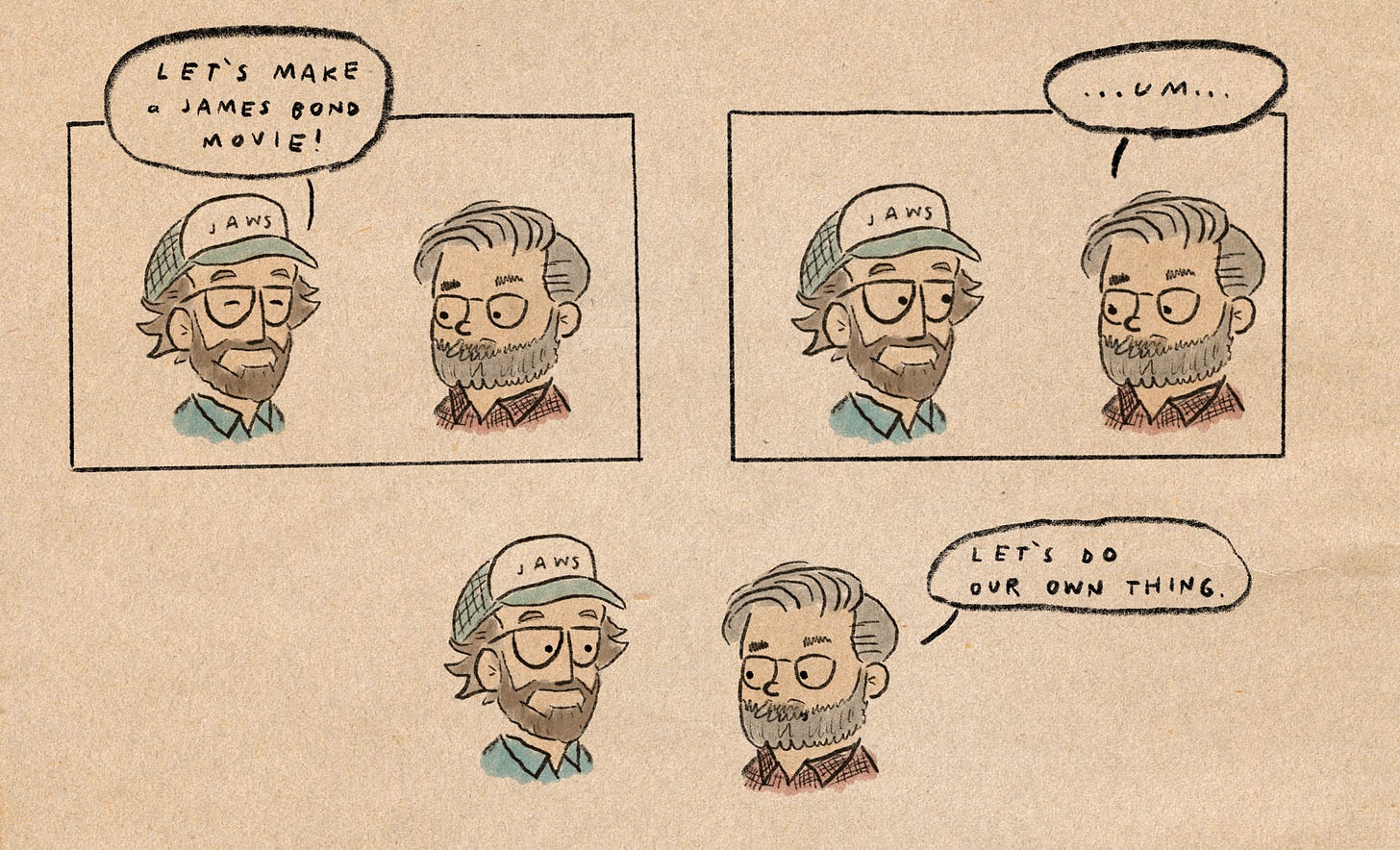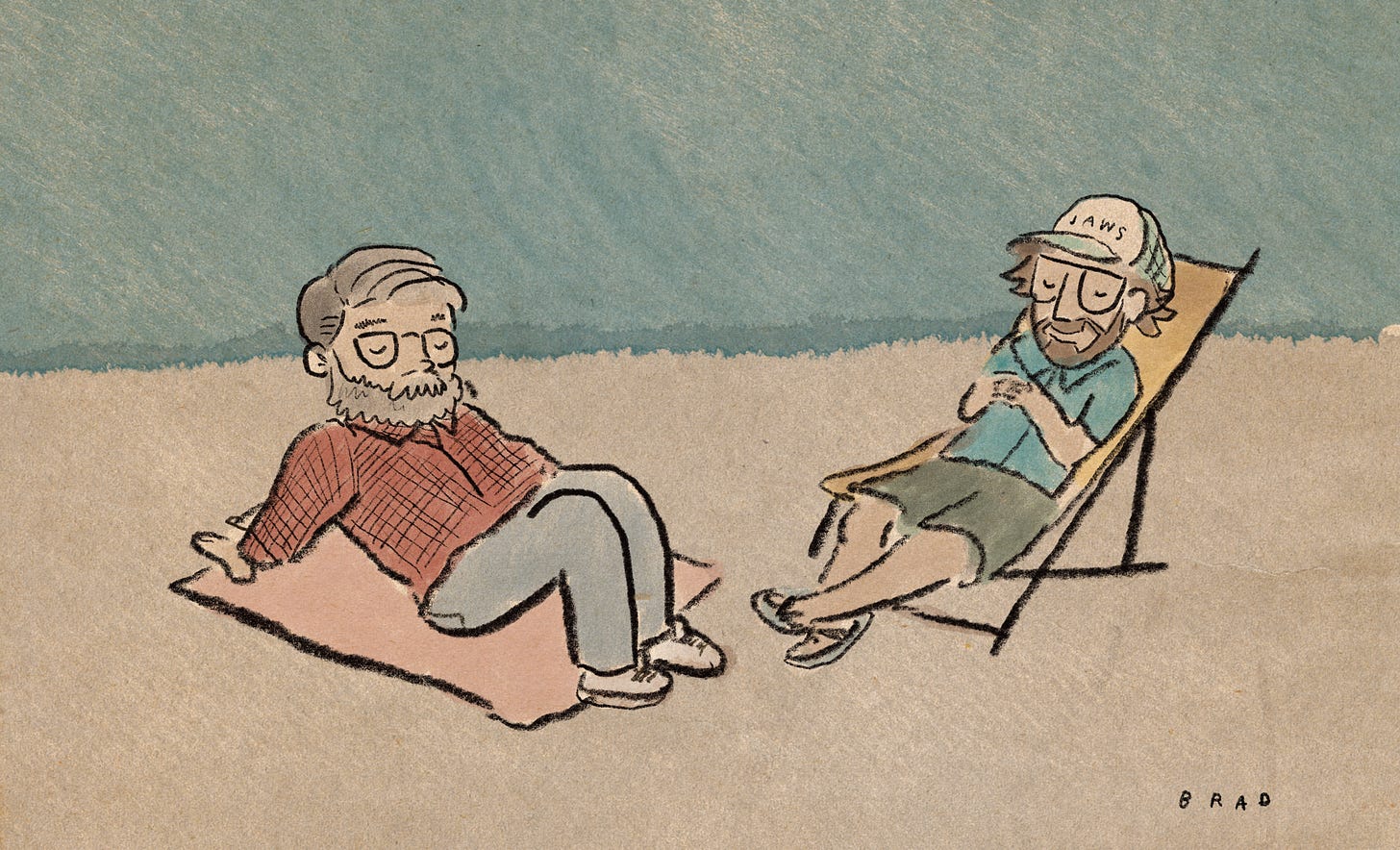3 helpful tips for creating something new
Spielberg and Lucas on the beach
One sunny day, two men stood on a beach.
The year was 1977.
While audiences were lining up to experience Star Wars for the very first time, George Lucas and Steven Spielberg were at the beach.
These two men had already seen success in the film industry. With 10 short films and two feature films (THX 1138 and American Graffiti), George Lucas, age 33, was eager to be far from the chaos of a major film release. Meanwhile, his friend, 31-year-old Steven Spielberg, had experienced tremendous success (and exhaustion) with the releases of Jaws and Close Encounters of the Third Kind.
Success, they had learned, was as draining as it was exhilarating.
While on the beach, Spielberg confessed a thwarted dream: directing a James Bond film.
Lucas recalls:
“Steven was telling me how he really wanted to do a James Bond film, and that he actually went to the people who owned James Bond and asked them if he could direct one … and they turned him down.”
Steven Spielberg wanted to direct a James Bond movie.
While the thought of a late 70s Bond film from a young Steven Spielberg is an exciting one, studios (and rights holders) had other ideas. Thankfully, George Lucas had other ideas, too.
Lucas: “Forget James Bond!
So I said, ‘Well, look, Steven, I’ve got a James Bond film. It’s great – it’s just like James Bond but even better.”
Back in 1973, Lucas had drafted an outline for an adventure movie titled The Adventures of Indiana Smith. He envisioned a character who was a "bounty hunter of antiquities," with a blend of academic prestige and rugged charm, aiming to create a hero that, unlike Bond, didn’t rely on high-tech gadgets.
The two friends had a shared love of 1940s and 50s adventure serials. Lucas, in particular, was fond of B-movies like China (1943) and Secret of the Incas (1954), which featured adventurous heroes with leather jackets and fedoras. When Lucas shared the concept with Spielberg, it wasn't just the potential for a single movie that excited them; it was the prospect of creating an entire series that would captivate audiences in the same way their beloved adventure films had.
This fascination laid the groundwork for what would become a cultural phenomenon.
Spielberg recounts: “I told George … It sounds amazing. We just need to change one thing: the name. Indiana Smith doesn't roll off the tongue well."
THREE THINGS FOR US:
As creators, entrepreneurs, or humans doing anything in the world, we stand at a crossroads similar to that faced by Lucas and Spielberg on that beach. We can choose the safety of the familiar, or we can dare to explore uncharted territory.
New is needed.
Except for Oppenheimer and The Sound of Freedom, last year’s 10 highest-grossing movies were all sequels, remakes, or based on pre-existing intellectual property.
We need new points of view. We need new worlds. We need new.
Lucas and Spielberg could’ve pursued more James Bond or Flash Gordon, but instead put their energy behind the new. Sure, they were deeply inspired by what came before them, but imbued everything with personal touches and fresh fingerprints.
Break away from the hairball.
Gordon MacKenzie wrote a great book called Orbiting the Giant Hairball: A Corporate Fool's Guide to Surviving with Grace. After more than 30 years at Hallmark, MacKenzie knew what company culture can do to the creative spirit. The book highlights the many benefits that can come from escaping our everyday.
To me, one of the most bonkers parts of the Lucas and Spielberg on the beach story is the timing. This took place during the opening weekend of Star Wars! Instead of getting swept up in the box-office receipts, film promotion, or audience reaction they went on a retreat.
Lucas and Spielberg understood early on in their careers, the value of breaking away. What’s your hairball? Break away from it and find that healthy place where the new can emerge.
The new needs friends.
Their friendship is what I love about this story. Great relationships help everything in their midst grow. Yes, George had tinkered with the heroic archeologist idea a few years prior, but it wasn’t until he shared it with Steven that it began to find life.
Their shared enthusiasm for classic movie serials mixed with their desire to impact culture created the perfect environment for this idea to thrive.
The food critic in Ratatouille had it right: “the new needs friends”. (Though in that instance the critic was speaking to how advocates of unproven ideas can change everything. My deep love of Ratatouille is a subject for another time.)
SO, BRAD, WHAT DID YOU THINK OF INDIANA JONES 5?
Look, that’s not what this post is about. Okay? But, yes, I saw the movie. I enjoyed it.
My invitation to you is this ….
My hope ….
My challenge to storytellers, culture shapers, makers, dreamers, doers, dentists, whatever….
bring on the new.
Maybe right now there’s two friends somewhere on a beach.
One friend says:
“I want to make an Indiana Jones movie!”
We desperately need the friend next to them to say:
“I’ve got another thought. Let’s do our own thing. A new thing!”
Seek out the fresh and the untried. Embrace the unknown. That’s where the real adventure is.
New in the store: STICKERS!
We purchased a few different cups to test-drive the stickers. I wanted to give you subscribers first dibs on not only the stickers but the cups. Today only, we’ll be giving away these cups to 5 random subscribers who order from our site. There’s a comments box on the checkout page. Put the words: FREE CUP!








Love the idea "the new needs friends". Reminds me of the Steinbeck line: "We are lonesome animals. We spend all of our life trying to be less lonesome. One of our ancient methods is to tell a story begging the listener to say-and to feel- ‘Yes, that is the way it is, or at least that is the way I feel it.’ You’re not as alone as you thought."
I am always trying to “be me” which I find is unique and different from other people. I do not do what other people are doing. I can only imagine if I put my head together with someone else who is just trying to be themselves what a new thing that would create.